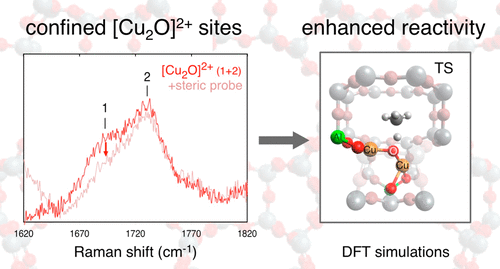当前位置:
X-MOL 学术
›
J. Am. Chem. Soc.
›
论文详情
Our official English website, www.x-mol.net, welcomes your
feedback! (Note: you will need to create a separate account there.)
Second-Sphere Effects on Methane Hydroxylation in Cu-Zeolites
Journal of the American Chemical Society ( IF 14.4 ) Pub Date : 2018-06-28 , DOI: 10.1021/jacs.8b05320 Benjamin E. R. Snyder 1 , Pieter Vanelderen 1, 2 , Robert A. Schoonheydt 2 , Bert F. Sels 2 , Edward I. Solomon 1
Journal of the American Chemical Society ( IF 14.4 ) Pub Date : 2018-06-28 , DOI: 10.1021/jacs.8b05320 Benjamin E. R. Snyder 1 , Pieter Vanelderen 1, 2 , Robert A. Schoonheydt 2 , Bert F. Sels 2 , Edward I. Solomon 1
Affiliation

|
Two [Cu2O]2+ cores have been identified as the active sites of low temperature methane hydroxylation in the zeolite Cu-MOR. These cores have similar geometric and electronic structures, yet different reactivity with CH4: one reacts with a much lower activation enthalpy. In the present study, we couple experimental reactivity and spectroscopy studies to DFT calculations to arrive at structural models of the Cu-MOR active sites. We find that the more reactive core is located in a constricted region of the zeolite lattice. This leads to close van der Waals contact between the substrate and the zeolite lattice in the vicinity of the active site. The resulting enthalpy of substrate adsorption drives the subsequent H atom abstraction step-a manifestation of the "nest" effect seen in hydrocarbon cracking on acid zeolites. This defines a mechanism to tune the reactivity of metal active sites in microporous materials.
中文翻译:

Cu-沸石中甲烷羟基化的第二球效应
两个 [Cu2O]2+ 核已被确定为沸石 Cu-MOR 中低温甲烷羟基化的活性位点。这些核心具有相似的几何和电子结构,但与 CH4 的反应性不同:一个反应的活化焓低得多。在本研究中,我们将实验反应性和光谱学研究与 DFT 计算相结合,以得出 Cu-MOR 活性位点的结构模型。我们发现反应性更强的核心位于沸石晶格的收缩区域。这导致基底和活性位点附近的沸石晶格之间的范德华密切接触。由此产生的底物吸附焓驱动了随后的 H 原子提取步骤——这是在酸性沸石上烃类裂解中看到的“巢”效应的表现。
更新日期:2018-06-28
中文翻译:

Cu-沸石中甲烷羟基化的第二球效应
两个 [Cu2O]2+ 核已被确定为沸石 Cu-MOR 中低温甲烷羟基化的活性位点。这些核心具有相似的几何和电子结构,但与 CH4 的反应性不同:一个反应的活化焓低得多。在本研究中,我们将实验反应性和光谱学研究与 DFT 计算相结合,以得出 Cu-MOR 活性位点的结构模型。我们发现反应性更强的核心位于沸石晶格的收缩区域。这导致基底和活性位点附近的沸石晶格之间的范德华密切接触。由此产生的底物吸附焓驱动了随后的 H 原子提取步骤——这是在酸性沸石上烃类裂解中看到的“巢”效应的表现。











































 京公网安备 11010802027423号
京公网安备 11010802027423号